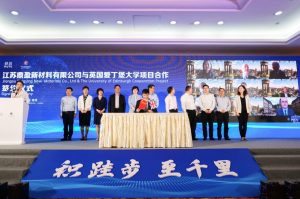
The University has signed a six-year collaborative research agreement with Jiangsu Dingying New Materials Co Ltd, worth £1.19 million.
Experts at the Institute for Materials and Processes within the University’s School of Engineering will research how to optimise two types of graphene-based material including nanostructured membranes to remove pollutants and extract useful substances from effluent liquids and gases.
The company will take the results and scale up production, for applications such as industrial waste management and chemical purification.
Partnership support
The University’s project team is led by Dr Harvey Huang and Professor Xianfeng Fan of the Institute for Materials and Processes. Their relationship with Jiangsu Dingying New Materials Co has been developing since 2017, supported by Edinburgh Innovations.
The signing of this agreement reflects hard work and determination by both sides to pursue our mutual interest in developing this field, and we’re very pleased to have helped achieve this successful outcome.
Dr George Baxter, CEO of Edinburgh Innovations.
Environmental benefits
Dr Harvey Huang, the principal investigator of the collaboration, said the research would facilitate the commercialisation of graphene-based materials and contribute to the worldwide efforts in waste management, energy-saving and pollution reduction.
This collaboration will help us find lower-cost and more sustainable routes to reducing pollution produced by industry, which when scaled up by our specialist partner company could bring significant environmental benefits.
Professor Conchúr Ó Brádaigh, Head of the School of Engineering.
Membrane nanostructures
A growing number of industrial uses have been discovered for graphene, a single layer of carbon atoms arranged in a 2D honeycomb structure, since its discovery in 2004.
As an inexpensive yet abundant oxidized form of graphene, graphene oxide is a promising material for graphene-based waste treatment and purification applications.
The collaboration aims to engineer the nanostructures of graphene-based membranes with enhanced structural stability to allow faster and more effective extraction of contaminants from water and to research the use of such membranes to extract toxic volatile organic compounds from industrial waste gas streams.
It will also seek to develop membranes with greater selectivity in their filtration so that they can extract lithium from waste or lithium-enriched brines for use in the battery sector, and for purification applications in the chemicals sector.